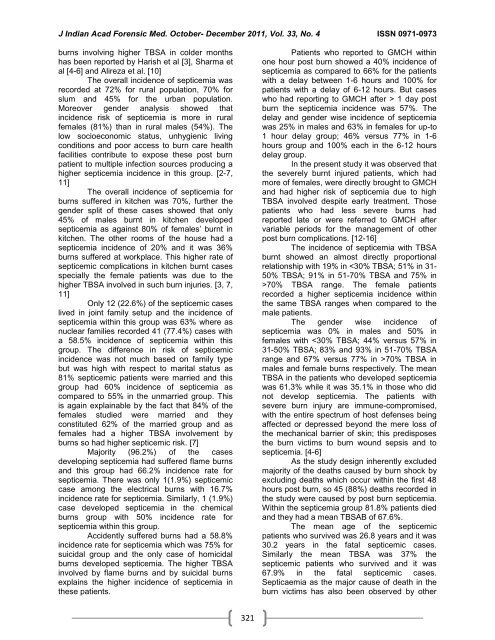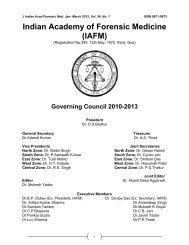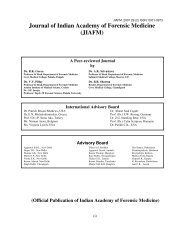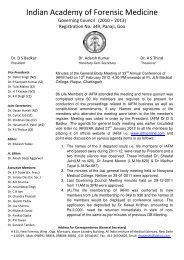Indian Academy of Forensic Medicine (IAFM) - Official website of IAFM
Indian Academy of Forensic Medicine (IAFM) - Official website of IAFM
Indian Academy of Forensic Medicine (IAFM) - Official website of IAFM
You also want an ePaper? Increase the reach of your titles
YUMPU automatically turns print PDFs into web optimized ePapers that Google loves.
J <strong>Indian</strong> Acad <strong>Forensic</strong> Med. October- December 2011, Vol. 33, No. 4 ISSN 0971-0973<br />
burns involving higher TBSA in colder months<br />
has been reported by Harish et al [3], Sharma et<br />
al [4-6] and Alireza et al. [10]<br />
The overall incidence <strong>of</strong> septicemia was<br />
recorded at 72% for rural population, 70% for<br />
slum and 45% for the urban population.<br />
Moreover gender analysis showed that<br />
incidence risk <strong>of</strong> septicemia is more in rural<br />
females (81%) than in rural males (54%). The<br />
low socioeconomic status, unhygienic living<br />
conditions and poor access to burn care health<br />
facilities contribute to expose these post burn<br />
patient to multiple infection sources producing a<br />
higher septicemia incidence in this group. [2-7,<br />
11]<br />
The overall incidence <strong>of</strong> septicemia for<br />
burns suffered in kitchen was 70%, further the<br />
gender split <strong>of</strong> these cases showed that only<br />
45% <strong>of</strong> males burnt in kitchen developed<br />
septicemia as against 80% <strong>of</strong> females‘ burnt in<br />
kitchen. The other rooms <strong>of</strong> the house had a<br />
septicemia incidence <strong>of</strong> 20% and it was 36%<br />
burns suffered at workplace. This higher rate <strong>of</strong><br />
septicemic complications in kitchen burnt cases<br />
specially the female patients was due to the<br />
higher TBSA involved in such burn injuries. [3, 7,<br />
11]<br />
Only 12 (22.6%) <strong>of</strong> the septicemic cases<br />
lived in joint family setup and the incidence <strong>of</strong><br />
septicemia within this group was 63% where as<br />
nuclear families recorded 41 (77.4%) cases with<br />
a 58.5% incidence <strong>of</strong> septicemia within this<br />
group. The difference in risk <strong>of</strong> septicemic<br />
incidence was not much based on family type<br />
but was high with respect to marital status as<br />
81% septicemic patients were married and this<br />
group had 60% incidence <strong>of</strong> septicemia as<br />
compared to 55% in the unmarried group. This<br />
is again explainable by the fact that 84% <strong>of</strong> the<br />
females studied were married and they<br />
constituted 62% <strong>of</strong> the married group and as<br />
females had a higher TBSA involvement by<br />
burns so had higher septicemic risk. [7]<br />
Majority (96.2%) <strong>of</strong> the cases<br />
developing septicemia had suffered flame burns<br />
and this group had 66.2% incidence rate for<br />
septicemia. There was only 1(1.9%) septicemic<br />
case among the electrical burns with 16.7%<br />
incidence rate for septicemia. Similarly, 1 (1.9%)<br />
case developed septicemia in the chemical<br />
burns group with 50% incidence rate for<br />
septicemia within this group.<br />
Accidently suffered burns had a 58.8%<br />
incidence rate for septicemia which was 75% for<br />
suicidal group and the only case <strong>of</strong> homicidal<br />
burns developed septicemia. The higher TBSA<br />
involved by flame burns and by suicidal burns<br />
explains the higher incidence <strong>of</strong> septicemia in<br />
these patients.<br />
321<br />
Patients who reported to GMCH within<br />
one hour post burn showed a 40% incidence <strong>of</strong><br />
septicemia as compared to 66% for the patients<br />
with a delay between 1-6 hours and 100% for<br />
patients with a delay <strong>of</strong> 6-12 hours. But cases<br />
who had reporting to GMCH after > 1 day post<br />
burn the septicemia incidence was 57%. The<br />
delay and gender wise incidence <strong>of</strong> septicemia<br />
was 25% in males and 63% in females for up-to<br />
1 hour delay group; 46% versus 77% in 1-6<br />
hours group and 100% each in the 6-12 hours<br />
delay group.<br />
In the present study it was observed that<br />
the severely burnt injured patients, which had<br />
more <strong>of</strong> females, were directly brought to GMCH<br />
and had higher risk <strong>of</strong> septicemia due to high<br />
TBSA involved despite early treatment. Those<br />
patients who had less severe burns had<br />
reported late or were referred to GMCH after<br />
variable periods for the management <strong>of</strong> other<br />
post burn complications. [12-16]<br />
The incidence <strong>of</strong> septicemia with TBSA<br />
burnt showed an almost directly proportional<br />
relationship with 19% in 70% TBSA range. The female patients<br />
recorded a higher septicemia incidence within<br />
the same TBSA ranges when compared to the<br />
male patients.<br />
The gender wise incidence <strong>of</strong><br />
septicemia was 0% in males and 50% in<br />
females with 70% TBSA in<br />
males and female burns respectively. The mean<br />
TBSA in the patients who developed septicemia<br />
was 61.3% while it was 35.1% in those who did<br />
not develop septicemia. The patients with<br />
severe burn injury are immune-compromised,<br />
with the entire spectrum <strong>of</strong> host defenses being<br />
affected or depressed beyond the mere loss <strong>of</strong><br />
the mechanical barrier <strong>of</strong> skin; this predisposes<br />
the burn victims to burn wound sepsis and to<br />
septicemia. [4-6]<br />
As the study design inherently excluded<br />
majority <strong>of</strong> the deaths caused by burn shock by<br />
excluding deaths which occur within the first 48<br />
hours post burn, so 45 (88%) deaths recorded in<br />
the study were caused by post burn septicemia.<br />
Within the septicemia group 81.8% patients died<br />
and they had a mean TBSAB <strong>of</strong> 67.6%.<br />
The mean age <strong>of</strong> the septicemic<br />
patients who survived was 26.8 years and it was<br />
30.2 years in the fatal septicemic cases.<br />
Similarly the mean TBSA was 37% the<br />
septicemic patients who survived and it was<br />
67.9% in the fatal septicemic cases.<br />
Septicaemia as the major cause <strong>of</strong> death in the<br />
burn victims has also been observed by other









